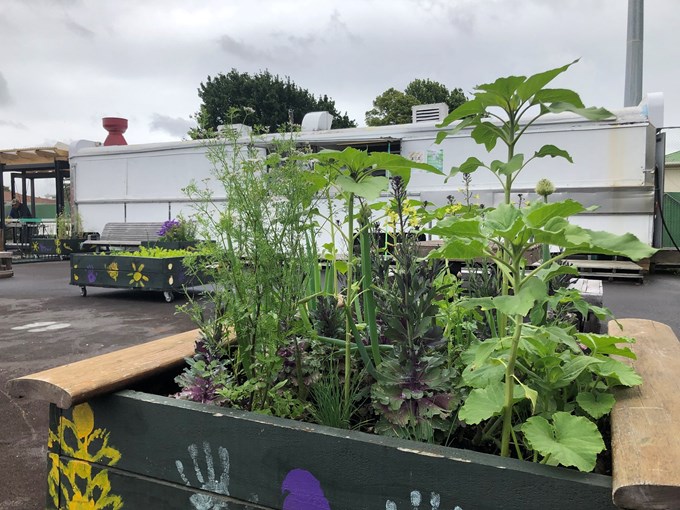From the outside, the Papatoetoe Food Hub looks like a simple community garden with a food truck. But, behind the scenes is a revolutionary approach to how we dine, that sits at the nexus of zero waste and easy access to fresh food.
New World Papatoetoe walks their excess fresh food items across the parking lot to the Food Hub, where a team of culinary experts turn them into great brunch items inspired by the cuisine of their home cultures.
The majority of food is grown on-site or donated from businesses or farmers. Fruits that escaped their packaging or greens that didn’t stay perky enough might be given a second life in a smoothie, curry, hangi, or omelette.

Raju Ramakrishna, one of the managers (above left), reckons, “It’s the best-kept secret in Auckland. When people come and have the experience, they return often. We are growing through our community connections rather than big promotions. We give away our recipes because our goal is to be a model that others can adapt rather than keep the profits for ourselves.”
Max McDermid, local New World Owner, (pictured above, right) was originally sceptical of the concept, but when he saw the popularity and ingenuity of the team, he was keen to get involved. He explains, “No one wants to see things go to landfill. And, we all want to do our little bit for the environment. The Papatoetoe Food Hub are a fantastic partner because they have great ideas and are always thinking ahead. They help us re-purpose things, so we can reduce our waste while connecting with the community that shops here.”
Together, they’ve been able to divert an average of 500 kg of food a week that used to be thrown away. What they can’t divert, the Whenua to Whenua project is composting on-site, using it as a demonstration plot that teaches visitors how to replicate those composting models at home.

Curator and carpenter Waikare Komene tends to the compost
This social enterprise keeps costs low to remain accessible to everyone in the neighbourhood. They’ve been able to break even this year in spite of the difficult operating environment. The Hub is located on a Panuku site, and the kitchen operates out of a retired iconic White Lady food truck. The concept and set up came from the Southern Initiative and Healthy Families South Auckland, who are working on a Good Food Road Map to achieve food security and ensure that food sovereignty remains in the control of our communities.
Councillor Richard Hills, Chair of the Environment and Climate Change Committee admires what they’ve achieved this year, saying, “Papatoetoe Food Hub is using the tradition of food to address multiple needs in the community all at once. They’ve worked hard to sustain themselves, reduce their waste, build their community up, be accessible to all while keeping the public good as their first outcome.”
“Food waste is almost half the weight of our rubbish bins. This innovation in dining helps people see how to reduce what’s wasted, which generates environmental benefits that the council is excited to be supporting,” says Councillor Hills.
One area in high demand is the hangi pit, made out of reclaimed wood. Michelle Potoru, Chef and Manager, shares, “It’s a way for us to nurture our traditions within the local community. We have four generations of locals working together using banana leaves and steam to teach kids how to pack the hangi. It’s a skill they can use for the rest of their lives.”
The hangi is also a popular catering option since they’re able to create up to 300 packs of food at an affordable price. If you’re dining alone, you can get a single serving of a boil up, too.

Michelle Potoru greets a customer in the café
When new opportunities arise, the team is quick to figure out how to make them work. During winter, they turned 1 tonne of vegetables from Pukekoe Farmers into a “Soup to School” scheme that fed around 2000 local kids with hot soup and bread. It’s a model they’d love to see carried into the school lunch programmes being designed across the country.
Papatoetoe Food Hub curator Waikare Komene says it’s all about community and food. “We’re upskilling people and at the same time creating delicious and affordable kai and juices.”
He says, “The Papatoetoe Food Hub is showing what’s possible when community and local government work together to tackle one of our toughest issues. But we’re not a food bank or a charity; it’s a collective of community-led enterprises aimed to be self-sustaining and employing local people.”
In a complex food system, it’s nourishing to the body and mind to see a model take root that’s placing control of food into the local communities. This resilient local café is replenishing Papatoetoe one great meal at a time. It’s a recipe for success that keeps on giving.


